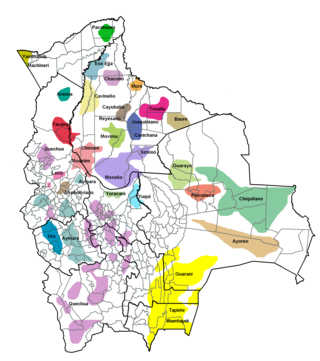|
Movima language
Movima is a language that is spoken by about 1,400 (nearly half) of the Movima, a group of Native Americans that resides in the Llanos de Moxos region of the Bolivian Amazon, in northeastern Bolivia. It is considered a language isolate, as it has not been proven to be related to any other language. LocationsMovima is spoken in the locations of 18 de Noviembre, 20 de Enero, Bella Flor, Buen Día, Carmen de Iruyañez, Carnavales, Ipimo, Miraflores, Navidad, San Lorenzo, and the town of Santa Ana del Yacuma.[2] The Movima community reported that there are approximately 500 adult speakers as of 2012.[4]: 807 PhonologyMovima has five vowels:
/e/ and /o/ more closely resemble [ɛ] and [ɔ], respectively, than the close-mid vowels [e] and [o]. Vowels have a phonemic length distinction, although some prosodic processes can lengthen otherwise short vowels. Movima does not have tone.[5]
The plosive /p/ is realized as [p] in the syllable onset but as [pʔᵐ] (which contrasts with the simple nasal phoneme /m/) in the coda. Similarly, /t/ and /k/ are realized as [tʔⁿ] and [ʔɤ] (i.e., as a glottal stop with a vocalic release), respectively, in the syllable coda.[1] In vowel-initial words and between adjacent vowels, an epenthetic glottal stop appears. The phonemes /f/ and /ɡ/ are only present in Spanish loanwords. MorphologyIn Movima, compounding and incorporation are productive derivational processes. Reduplication and affixation, including some processes (such as the irrealis marker (k)a') that resemble infixation, are also common. Typical examples of inflection, such as number, case, tense, mood, and aspect, are not obligatorily marked in Movima.[1] Many derivational processes can be applied to a single Movima word. The same morpheme may appear multiple times in one word this way, for instance, tikoy-na-poj-na "I make X kill Y." VocabularyLoukotka (1968) lists the following basic vocabulary items.[6]
Further vocabulary:
See alsoFurther reading
References
External links
|
||||||||||||||||||||||||||||||||||||||||||||||||||||||||||||||||||||||||||||||||||||||||||||||||||||||||||||||||||||||||||||||||||||||||||||||||||||||||||||

